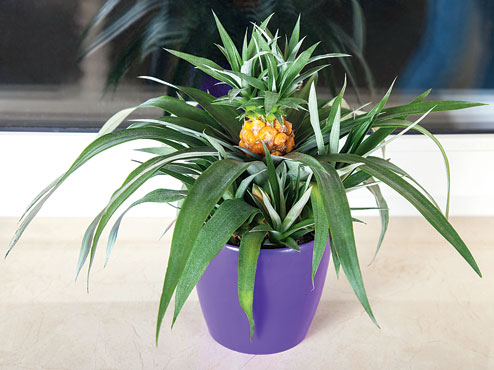Cook it, juice it, can it or eat it fresh. Once indigenous to Brazil, the pineapple is today relished and grown around the world. Salt Lake’s soil, in particular, is highly suitable for the plant and gardeners here grow them in containers, if not for consumption for decoration.
The plant is scientifically known as Ananas Comosus and belongs to the Bromeliad family. It was introduced to India around 1548 and by 2016 is grown almost throughout the country. In Bengal it is grown abundantly in the districts of Darjeeling, Jalpaiguri, West Dinajpur and in parts of South 24 Parganas. It is grown commercially mainly to can and juice.
In gardens, a popular variant is the Red Pineapple. These make great ornamental houseplants what with their long striped leaves with serrated spines. This plant has a strong sculptural quality and looks elegant. It can be grown in a mixture of equal parts of soil-based compost, coarse pit or leaf mould.

Right conditions
The Pineapple is a crop of humid tropics. A warm, sunny and frost-free climate is essential for growing it. It can be grown at up to 1,100m above mean sea level, provided the area is frost-free.
Although optimum annual rainfall for Pineapple cultivation is 100-150cm, it grows well under a wide range of rainfall. The optimum temperature for its successful cultivation is 16-32°C.
The plants come up on any type of soil except heavy clay soil. Sandy loam soils are ideal. Pineapples prefer a soil pH of five to six, that is slightly acidic in nature. In fact the quality of fruits grown in light soils is usually superior.
A free draining soil is absolutely essential as the plant is shallow-rooted and susceptible to stem and root rot. Kew, Queen and Mauritius are three popular varieties of Pineapples. Kew produces large fruits and is mostly used for canning. The other two have smaller fruits considered to be of superior quality. Kew is a late fruiting variety; Queen is early, while Mauritius is intermediate.
Pineapples are propagated vegetatively by using slips, suckers or the leafy crown of the fruit. Slips are offshoots, arising from the fruit stalk, whereas the sucker is a short shoot arising from the base of the plant. The simplest means of starting a pineapple plant is to use the leafy crown of the fruit.
Cut this off close to the fruit with a sharp knife, ensuring that you do not cut through the base of the shoot. Remove the bottom leaves, dip in fungicide solution then leave upside down to dry out for a few days. Insert the prepared cutting into a pot of cutting compost. The cutting will be ready to plant in a few weeks.

In case of slips and suckers, these may be detached with a sharp knife and the same procedure as above may be followed for propagation.
In Bengal the ideal time for planting is October to November. Before planting, the bed should be prepared thoroughly by proper hoeing and 3-5kg of Farm Yard Manure (FYM) per sq-m should be applied. The plants are generally set 50-60cm apart in rows, which are 60-90cm apart.
For larger plantings pineapples are best grown in raised beds in double rows, each row spaced 60cm apart and the individual plants spaced 25-30cm. If planted in a pot, use pots of at least 12in diameter and make sure that the potting media is prepared with high organic content manure and is well drained.
The Pineapple is a shallow feeder with nitrogen and potassium requirement. It is thus advisable to apply nitrogen and potassium each at the rate of 12g/plant. However if the soil is poor, phosphorus at the rate of 4g/plant may be applied. The first dose of fertilizer can be applied two months after planting and the last one eight months after planting. During scanty rainfall and dry weather it is advisable to water the Pineapple.
Pineapple plants flower 10 to 12 months after planting and fruits become ready 15 to 18 months after planting. The fruit develops from the apex of the stem at the centre of the plant. Each stem produces only one Pineapple. In commercial cultivation the time of flower initiation can be manipulated by applying plant growth regulator.
For canning purposes harvest the fruits when they begin to turn yellow. But for table purpose the fruits could be retained till they develop a golden yellow colour.
PINEAPPLE UPSIDE DOWN CAKE

Ingredients
For cake-
Flour- 100g
Softened butter- 100g
Golden caster sugar- 100g
Eggs- 2
Pineapple syrup- 2 tbsp
Baking powder- 1 tsp
Vanilla extract- 1 tsp
For topping-
Pineapple- a few slices cut in the shape of rings
Softened butter- 50g
Brown sugar- 50g
Method
Heat oven to 18°C.
Start by beating the butter and sugar together till creamy. You’ll have to spread it over the base and a bit of the sides of a 20cm round cake tin. Decorate the pineapple rings on it and put cherries at their centre if you wish. This will form the cake’s topping.
As for the cake, place the ingredients in a bowl and whisk till it attains a soft consistency. Pour it into the cake tin and bake for just over 30 minutes. Leave it to stand for five minutes and then flip over on to a plate so the pineapples face upwards. Serve warm.
♦ To be continued











